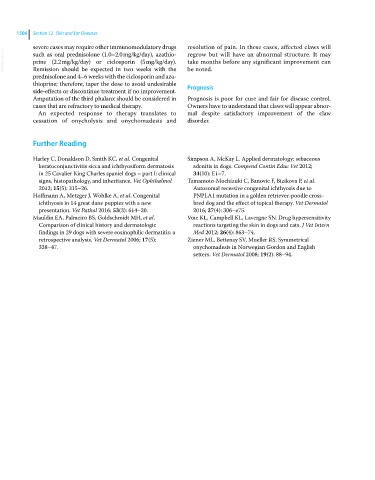Page 1568 - Clinical Small Animal Internal Medicine
P. 1568
1506 Section 12 Skin and Ear Diseases
severe cases may require other immunomodulatory drugs resolution of pain. In these cases, affected claws will
VetBooks.ir such as oral prednisolone (1.0–2.0 mg/kg/day), azathio- regrow but will have an abnormal structure. It may
take months before any significant improvement can
prine (2.2 mg/kg/day) or ciclosporin (5 mg/kg/day).
Remission should be expected in two weeks with the
prednisolone and 4–6 weeks with the ciclosporin and aza- be noted.
thioprine; therefore, taper the dose to avoid undesirable Prognosis
side‐effects or discontinue treatment if no improvement.
Amputation of the third phalanx should be considered in Prognosis is poor for cure and fair for disease control.
cases that are refractory to medical therapy. Owners have to understand that claws will appear abnor-
An expected response to therapy translates to mal despite satisfactory improvement of the claw
cessation of onycholysis and onychomadesis and disorder.
Further Reading
Harley C, Donaldson D, Smith KC, et al. Congenital Simpson A, McKay L. Applied dermatology: sebaceous
keratoconjunctivitis sicca and ichthyosiform dermatosis adenitis in dogs. Compend Contin Educ Vet 2012;
in 25 Cavalier King Charles spaniel dogs – part I: clinical 34(10): E1–7.
signs, histopathology, and inheritance. Vet Ophthalmol Tamamoto‐Mochizuki C, Banovic F, Bizikova P, et al.
2012; 15(5): 315–26. Autosomal recessive congenital ichthyosis due to
Hoffmann A, Metzger J, Wohlke A, et al. Congenital PNPLA1 mutation in a golden retriever‐poodle cross‐
ichthyosis in 14 great dane puppies with a new bred dog and the effect of topical therapy. Vet Dermatol
presentation. Vet Pathol 2016; 53(3): 614–20. 2016; 27(4): 306–e75.
Mauldin EA, Palmeiro BS, Goldschmidt MH, et al. Voie KL, Campbell KL, Lavergne SN. Drug hypersensitivity
Comparison of clinical history and dermatologic reactions targeting the skin in dogs and cats. J Vet Intern
findings in 29 dogs with severe eosinophilic dermatitis: a Med 2012; 26(4): 863–74.
retrospective analysis. Vet Dermatol 2006; 17(5): Ziener ML, Bettenay SV, Mueller RS. Symmetrical
338–47. onychomadesis in Norwegian Gordon and English
setters. Vet Dermatol 2008; 19(2): 88–94.

